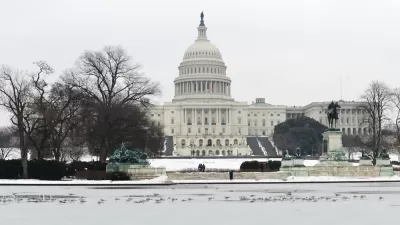A proposed Climate Planning Unit could help the federal government guide comprehensive climate policy and manage project costs.

A report from the Brookings Institution outlines suggestions for "how the White House can immediately kick-start climate solutions across our built environment through a new Climate Planning Unit (CPU)." The report suggests that the proposed office could "reduce the federal fiscal impacts of climate change by developing strategic intra-agency and cross-agency mitigation and adaptation projects and programs." By creating a federal office focused on climate change, the government can more effectively "identify opportunities (and outcomes) of effective climate action with direct and capturable federal financial benefits."
Federal investment in coordinated climate change policy has the potential to elevate climate concerns in development policies across the country, write Joseph W. Kane, Jenny Schuetz, Shalini Vajjhala, and Adie Tomer. "For instance, an 18F model can serve as a template for staffing, funding, and growing a new, dedicated federal unit focused on forward-looking research, metrics, and plans." The Blueprint developed by the Brookings Institution "supports the new high-level international and domestic climate leadership in the White House by establishing a stable basis for long-term, fiscally defensible, bipartisan federal climate action to complement other legislative and executive actions." The report also recommends a focus on "low-hanging fiscal fruit" that can help projects get off the ground faster and kickstart long-term efforts.
FULL STORY: How a federal Climate Planning Unit can manage built environment risks and costs

Alabama: Trump Terminates Settlements for Black Communities Harmed By Raw Sewage
Trump deemed the landmark civil rights agreement “illegal DEI and environmental justice policy.”

Planetizen Federal Action Tracker
A weekly monitor of how Trump’s orders and actions are impacting planners and planning in America.

Why Should We Subsidize Public Transportation?
Many public transit agencies face financial stress due to rising costs, declining fare revenue, and declining subsidies. Transit advocates must provide a strong business case for increasing public transit funding.

Understanding Road Diets
An explainer from Momentum highlights the advantages of reducing vehicle lanes in favor of more bike, transit, and pedestrian infrastructure.

New California Law Regulates Warehouse Pollution
A new law tightens building and emissions regulations for large distribution warehouses to mitigate air pollution and traffic in surrounding communities.

Phoenix Announces Opening Date for Light Rail Extension
The South Central extension will connect South Phoenix to downtown and other major hubs starting on June 7.
Urban Design for Planners 1: Software Tools
This six-course series explores essential urban design concepts using open source software and equips planners with the tools they need to participate fully in the urban design process.
Planning for Universal Design
Learn the tools for implementing Universal Design in planning regulations.
Caltrans
Smith Gee Studio
Institute for Housing and Urban Development Studies (IHS)
City of Grandview
Harvard GSD Executive Education
Toledo-Lucas County Plan Commissions
Salt Lake City
NYU Wagner Graduate School of Public Service





























